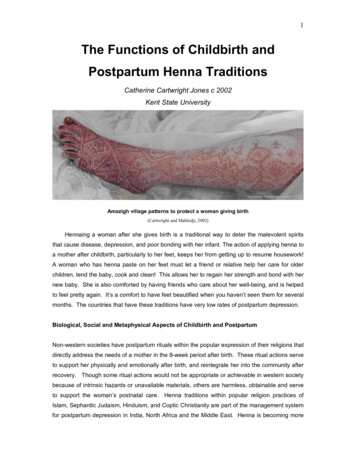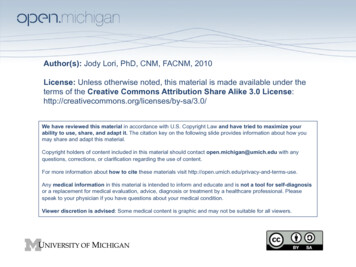
Transcription
Duncan et al. BMC Pregnancy and Childbirth (2017) 17:140DOI 10.1186/s12884-017-1319-3RESEARCH ARTICLEOpen AccessBenefits of preparing for childbirth withmindfulness training: a randomizedcontrolled trial with active comparisonLarissa G. Duncan1,2,3*, Michael A. Cohn3, Maria T. Chao3,4, Joseph G. Cook3, Jane Riccobono5 and Nancy Bardacke3,6,7AbstractBackground: Childbirth fear is linked with lower labor pain tolerance and worse postpartum adjustment. Empiricallyvalidated childbirth preparation options are lacking for pregnant women facing this problem. Mindfulness approaches,now widely disseminated, can alleviate symptoms of both chronic and acute pain and improve psychological adjustment,suggesting potential benefit when applied to childbirth education.Methods: This study, the Prenatal Education About Reducing Labor Stress (PEARLS) study, is a randomized controlled trial(RCT; n 30) of a short, time-intensive, 2.5-day mindfulness-based childbirth preparation course offered as a weekendworkshop, the Mind in Labor (MIL): Working with Pain in Childbirth, based on Mindfulness-Based Childbirth and Parenting(MBCP) education. First-time mothers in the late 3rd trimester of pregnancy were randomized to attend either the MILcourse or a standard childbirth preparation course with no mind-body focus. Participants completed self-reportassessments pre-intervention, post-intervention, and post-birth, and medical record data were collected.Results: In a demographically diverse sample, this small RCT demonstrated mindfulness-based childbirth educationimproved women’s childbirth-related appraisals and psychological functioning in comparison to standard childbirtheducation. MIL program participants showed greater childbirth self-efficacy and mindful body awareness (but nochanges in dispositional mindfulness), lower post-course depression symptoms that were maintained throughpostpartum follow-up, and a trend toward a lower rate of opioid analgesia use in labor. They did not, however,retrospectively report lower perceived labor pain or use epidural less frequently than controls.Conclusions: This study suggests mindfulness training carefully tailored to address fear and pain of childbirth may leadto important maternal mental health benefits, including improvements in childbirth-related appraisals and theprevention of postpartum depression symptoms. There is also some indication that MIL participants may usemindfulness coping in lieu of systemic opioid pain medication. A large-scale RCT that captures real-time painperceptions during labor and length of labor is warranted to provide a more definitive test of these effects.Trial registration: The ClinicalTrials.gov identifier for the PEARLS study is: NCT02327559. The study was retrospectivelyregistered on June 23, 2014.Keywords: Mindfulness, Childbirth, Labor, Fear, Pain, Postpartum depression* Correspondence: larissa.duncan@wisc.edu1School of Human Ecology, University of Wisconsin-Madison, Madison,Wisconsin, USA2Department of Family Medicine and Community Health, University ofWisconsin-Madison, Madison, Wisconsin, USAFull list of author information is available at the end of the article The Author(s). 2017 Open Access This article is distributed under the terms of the Creative Commons Attribution 4.0International License (http://creativecommons.org/licenses/by/4.0/), which permits unrestricted use, distribution, andreproduction in any medium, provided you give appropriate credit to the original author(s) and the source, provide a link tothe Creative Commons license, and indicate if changes were made. The Creative Commons Public Domain Dedication o/1.0/) applies to the data made available in this article, unless otherwise stated.
Duncan et al. BMC Pregnancy and Childbirth (2017) 17:140BackgroundFear of childbirth poses substantial risks to healthyadjustment from pregnancy through birth and into theearly postpartum period. It is related to low childbirth selfefficacy, greater use of pain medication during labor, moreunwanted obstetric interventions in labor [1–3], as well asincreased risk of postpartum depression (PPD) [4]. Childbirth education courses are the primary mechanism bywhich pregnant women learn strategies for coping withlabor pain, yet childbirth education has limited efficacy forreducing childbirth fear and in some cases may even causewomen to doubt their ability to cope with childbirth [5],increasing fear. With over 3.9 million births in the UnitedStates (U.S.) per year [6], innovative and accessible interventions for addressing childbirth fear and pain are critically needed. Mindfulness training – long used as a methodfor promoting coping with chronic pain [7, 8] and shownto be beneficial for acute pain [9, 10] – provides a noveland promising strategy for preparing women for childbirth.Childbirth fear, including its hallmark indicator of lowchildbirth self-efficacy, predicts poorer labor and deliveryrelated outcomes. Alehagen and colleagues [1] comparedprimiparous and multiparous women and found thatfirst time mothers had higher levels of fear of childbirth.Fear of childbirth in early labor predicted the totalamount of pain medication used during the labor. Datafrom the Danish National Birth Cohort of over 25,000nulliparous women indicate that fear of childbirth duringpregnancy, particularly in late pregnancy (around 31 weeks),was related to a higher risk of emergency Cesarean section,controlling for other risk factors (i.e., weight gain, birthweight, head circumference, and duration of pregnancy)[2]. These findings suggest the potential utility of intervening with first time mothers in the 3rd trimester to reducechildbirth fear and pain and improve perinatal outcomes.Fear of childbirth and negative birth experiences arelinked with depression, all of which can lead to poorermother-infant adjustment in the perinatal and postpartumperiods. In a sample of 89 women, pain catastrophizingscores collected during active labor prior to the administration of analgesia predicted both postpartum depressionand social functioning 6 weeks post-birth [11]. Antenataldepression often goes undiagnosed and untreated; available treatments for PPD include psychotherapy and antidepressant medication, but barriers to therapy (e.g., stigmaconcerns, time/expense involved) and risks of medicationto breastfeeding infants restrict access to those treatments[12]. Data from trials of mindfulness interventions haveconsistently shown a beneficial effect on depression symptoms and other mood disorders [13–15]. Incorporatingmindfulness into childbirth education available to the general public offers pregnant women experiencing depression symptoms, or otherwise at-risk for PPD, analternative, stigma-free strategy for addressing thesePage 2 of 11concerns while protecting their ability to engage inmedication-free breastfeeding and sensitive, responsivemother-infant interactions.The current studyWe developed the Mind in Labor (MIL): Working withPain in Childbirth (author NB), a childbirth educationprogram that teaches mindfulness skills for coping withchildbirth pain and fear in a short, time-intensive 2.5day weekend workshop. We hypothesized that mindfulness training through MIL would: 1) produce an adaptive shift in fear and pain-related appraisals of childbirth,thereby increasing childbirth self-efficacy and reducingpain catastrophizing; 2) lead to lower labor pain ratings,less use of pain medication in labor, and greater birthsatisfaction; and 3) lower perinatal depression symptomsand protect against postpartum depression. This study,the Prenatal Education About Reducing Labor Stress(PEARLS) study, is a small, randomized controlled trial(RCT) testing these hypotheses in a comparison of MILagainst a treatment-as-usual (TAU) active control condition of standard childbirth education with no mind-bodyfocus.MethodsParticipantsInclusion criteria: participants were English-speakingnulliparous women with low-risk, healthy, singleton pregnancies in their t ting; Cronbach’s α ranging from .66 to .87).ResultsAll analyses were conducted as intention to treat analyses with the sample of n 29 (n 14 control and n 15 MIL). Results in Table 1 exclude n 2 participantswho did not experience labor for whom the analysiswas therefore not valid.Treatment group equivalenceSee Table 2 for means and standard deviations for theprimary and secondary study outcomes. The two groups(MIL and TAU) were compared at baseline using t-testsand found to be equivalent (no statistically significantgroup differences prior to intervention participation). Ofthe n 29 study participants, n 4 experienced Cesareansection (n 2 per condition), and among those n 2experienced no labor (n 1 per condition). Only n 1Table 1 Crosstabulation of opioid analgesia use by studyconditionLabor pain management:Use of opioid analgesiaStudy bsample analyzed: n 26; n 3 participants excluded (n 2 who experiencedno labor due to Cesarean births and 1 with missing data)
Duncan et al. BMC Pregnancy and Childbirth (2017) 17:140Page 6 of 11Table 2 Descriptive statistics by study condition for primary and secondary outcome variablesControlMILT1:3rd Trimester BaselineMean (SD)aT2:Post-Intervention(prior to birth)Mean (SD)T3:Post-birthMean (SD)T1:3rd Trimester BaselineMean (SD)aT2:Post-Intervention(prior to birth)Mean (SD)T3:Post-birthMean (SD)CBSEI197.3 (49.0)212.0 (35.4)N/A165.1 (87.2)243.3 (41.6)N/APCS18.7 (8.4)18.5 (8.6)N/A18.5 (10.8)14.9 (6.4)N/AMAIA2.9 (0.6)3.0 (0.7)N/A2.5 (0.8)3.1 (0.5)N/AFFMQ3.5 (0.3)3.6 (0.41)3.6 (0.55)3.4 (0.4)3.5 (0.3)3.5 (0.4)CES-D8.2 (6.4)10.3 (7.6)12.9 (9.1)11.2 (9.4)7.9 (4.7)8.3 (6.1)W-DEQ65.7 (11.9)62.5 (13.0)61.6 (20.8)67.1 (23.2)58.0 (12.2)57.1 (13.4)aAt T1/baseline, no statistically significant differences were observed between control and MIL groupsparticipant (in the control condition) had an instrumentassisted spontaneous vaginal birth; she used opioidanalgesia. The remainder of participants (n 24) hadspontaneous vaginal births.Childbirth appraisalsChildbirth self-efficacyChildbirth self-efficacy (measured with the CBSEI,efficacy subscale) increased by an average of 14.7points in the TAU group and 78.2 points in the MILFig. 2 Childbirth Self-Efficacy scores (MIL Mind in Labor; TAU Treatment as Usual)group (see Fig. 2). To assess differential treatmenteffects, we constructed a linear mixed model with random participant intercepts using R statistical softwarewith the Zelig library [28, 29]. Groups were dummycoded as 0 TAU and 1 MIL. There was a significanttime*group interaction (t 2.21, p .04), indicatingthat the MIL group improved significantly more (estimatedtreatment effect 64.4 points, 80% CI [26.1, 102.7]). Inaddition, the effect for time was nonsignificant (t .65,p .52), indicating that the increase in the TAU groupFig. 3 Pain Catastrophizing scores (MIL Mind in Labor; TAU Treatment as Usual)
Duncan et al. BMC Pregnancy and Childbirth (2017) 17:140Page 7 of 11was not by itself significantly different from zero. Oneof the randomized participants was missing a CBSEIscore post-intervention. We re-ran these analyses withmultiple imputation using the Amelia II library [30](http://gking.harvard.edu/amelia) with the EM algorithmfor estimation. In the imputed dataset the estimated coefficients did not change substantially and the critical time*group interaction remained significant (t 2.18, p .03).Pain catastrophizingPain catastrophizing (measured with the PCS) droppedby 3.6 points in the MIL group and was essentially unchanged in the TAU group (see Fig. 3). The time*group interaction was not significant (t -1.06, p .30;estimated treatment effect -3.26 points, 80% CI [-7.3,0.8]). When the missing data was imputed, the resultdid not change (t -.71, p .48).Pain medication use in laborWe tested for group differences in use of two types of painmedication during labor. Two participants were excludedfrom this analysis because they did not experience labordue to scheduled Cesarean. The rate of narcotic use was30.8% (n 4) in the MIL group and 61.5% (n 8) in thecontrol group. Despite this very large risk ratio (RR .50),the difference showed only a trend toward statisticalsignificance (Pearson χ2 (df 1) 2.48, p .12) (SeeTable 1). Epidural use was uniformly high and did notdiffer between groups: 85.7% (n 12) in the MIL groupand 84.6% (n 11) in the control group (Pearson χ2 (df 1) .01, p .94).Fig. 4 CES-D depression symptom scores (MIL Mind in Labor;TAU Treatment as Usual)missing data was imputed, the treatment effect remainedsignificant (t 2.05, p .04). Mindfulness as measuredby the FFMQ scale increased by an average of .09 points(per item) in the TAU group and .08 points in the MILgroup. The time*group interaction was not significant(t -.12, p .91; estimated treatment effect -.01 points,80% CI [.-16, .13]). When the missing data was imputed,the result did not change (t .01, p .99).Restrospective perceived labor painFor analysis of labor pain, we averaged each participant’sfour retrospective VAS scores (early stage, active, pushing,and final). We identified narcotic use, epidural use, pitocin,and birth weight as a priori covariates of interest. These covariates were not significantly associated with retrospectiveperceived pain either singly (all p .36) or in a simultaneousmodel (multiple R2 .19, p .22). Condition was marginallyassociated with pain, with higher scores for MIL participants (average score of 5.20 on the 1-10 VAS) than for control participants (average score of 3.88; b 1.32, p .07).When condition was entered in a model with the fourcovariates, its estimated effect dropped slightly (b 1.08, p .14) and the model overall was nonsignificant(multiple R2 .29, p .15).Body awareness and mindfulnessBody awareness measured by the MAIA scale increasedby an average of .10 points (per item) in the TAU groupand .56 points in the MIL group. The time*group interaction was significant (t 2.25, p .03; estimated treatment effect .46 points, 80% CI [.19, .72]). When thePerinatal and postpartum depression symptomsDepression symptoms (measured by the CES-D) were analyzed at pre-treatment, post-treatment, and follow-up.Scores dropped by 3.3 points in the MIL condition frompre- to post-treatment, and this improvement was largelymaintained at follow-up (see Fig. 4). We constructed a linear mixed model similar to that used for the other questionnaire measures; time was treated as a simple linearfactor (coded 0 at pre-treatment, 1 at post-treatment, and2 at follow-up). The interaction between group and timewas significant: t -2.13, p .04. The estimated treatment effect – reflecting the amount by which the twogroups diverged at each time point – was -3.34 (80% CI[-5.22, -1.28]). A marginal main effect for time indicated that the increase in depression for the TAU groupmay have been statistically significant in itself (estimated effect 2.07 points per time point, t 1.86, p .07). Two CES-D scores were missing; one at posttreatment and one at follow-up. When missing datawere imputed, the interaction between group and timeremained significant (t -2.12, p .03). [Note. We re-
Duncan et al. BMC Pregnancy and Childbirth (2017) 17:140ran these analyses with timepoint as a categorical variable, reflecting the fact that change in depression mightnot be linear. The results were very similar to thosepresented here, with significant results for the criticalinteraction at follow-up and marginally significant results at post-treatment.].Birth satisfactionBirth satisfaction was assessed postnatally using twomeasures: the W-DEQ and the single-item satisfactionrating. Average W-DEQ scores were 57.1 in the MILgroup and 61.6 in the control group, both near the middle of the possible range (0 – 144). The group differencewas not significant (t .72, p .48). Scores on the singleitem satisfaction rating were very high and likely showeda ceiling effect: the overall mean response was 7.9 on a1–10 scale, and a plurality of participants in both groupsresponded with a 9 or 10 (57% of control and 47% ofMIL). To deal with the non-normality of the data, we dichotomized responses into 8 vs. 8. There was no difference between groups (Pearson χ2 (df 1) .51, p .47).DiscussionPrevious interventions for childbirth pain and fear havefocused almost exclusively on: a) pharmacologic painmanagement strategies that are important to provide asavailable options under the standard of care but alsopose health risks for the mother and fetus [31], and b)childbirth education that is geared toward increasingfactual knowledge about the stages and mechanics oflabor and birth, potential problems faced in labor anddelivery, and medical interventions that are available toaddress those problems. Childbirth education is theprimary mechanism by which pregnant women learnstrategies for coping with pain in labor, yet in itsstandard form it may fail to reduce fear of childbirth[5]. We found that participation in the MIL, a short,time-intensive weekend workshop form of childbirtheducation that incorporates mindfulness can lead tosignificant increases in childbirth self-efficacy notfound through participation in standard childbirtheducation programs. These results are consistent witha single-arm trial conducted of a Mindfulness-BasedChildbirth Education course in Australia [32] in whichparticipants experienced large improvements in childbirth self-efficacy and fear of childbirth. Approachinglabor with a greater sense of self-effica
MIL is a brief intervention for pregnant women and their partners specifically designed to target labor-related fear and pain by teaching tailored mindfulness-based coping strategies. It is a childbirth-specific, short form of the nine-week Mindfulness-Based Childbirth and Parenting program (MBCP) [16] adapted startingin1998fromMindfulness-










